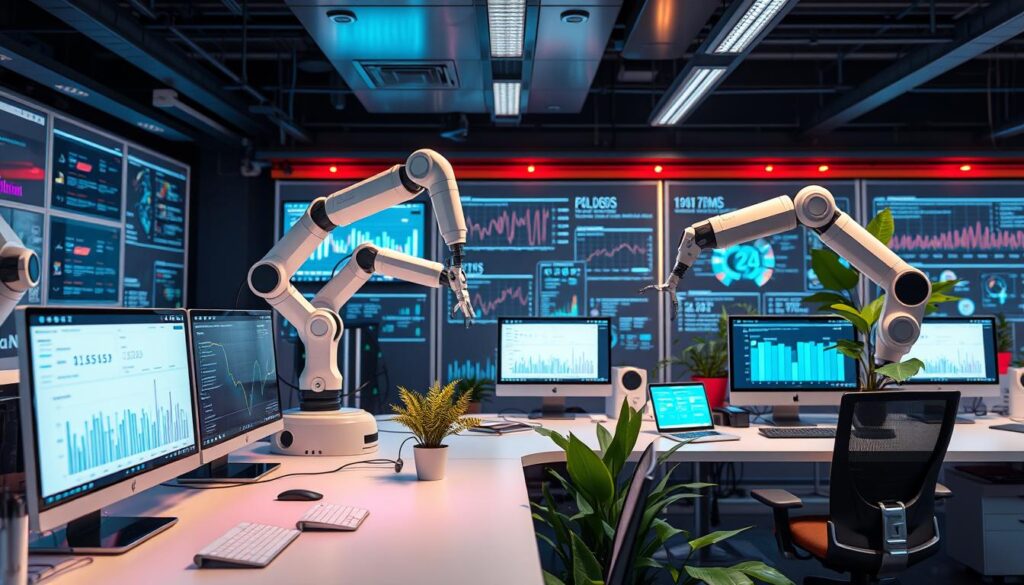In today’s digital world, businesses are looking for new ways to improve their workflows. They want to grow sustainably. AI-powered tools and automation are key to this change. They help us work smarter, be more productive, and find new chances for our companies.
At the core of this change is automating routine tasks. This frees us up to tackle bigger, more important tasks. AI tools can handle many business tasks fast and accurately. By using these tools, we can work more efficiently and stay ahead in a fast-changing world.
Key Takeaways
- AI-powered tools and automation can revolutionize business workflows, driving efficiency and productivity.
- Leveraging AI enables the automation of repetitive tasks, allowing teams to focus on strategic priorities.
- Integrating AI-powered solutions can unlock new opportunities for growth and innovation across various industries.
- Adopting AI-powered workflow automation can help organizations stay competitive in the digital age.
- Harnessing the power of AI can transform the way we approach business operations and decision-making.
Understanding AI-Powered Workflow Automation
AI-powered workflow automation is changing how businesses work. It uses machine learning, predictive analytics, and process optimization. These tools make our daily tasks more efficient.
Let’s dive into what makes this technology special. We’ll see how it can help businesses grow.
Key Components of AI Automation
AI workflow automation has a few key parts. Machine learning looks at data to make decisions. Predictive analytics helps the system adjust to new needs. Natural language processing lets the system understand and talk to us.
The Evolution of Workflow Technology
Workflow automation has come a long way. It started with simple task management and now uses AI. Businesses want to work smarter and faster, so they need better tools.
These tools learn from past experiences. They get better over time.
Core Benefits for Businesses
- Increased productivity and cost savings by automating repetitive tasks
- Enhanced decision-making through data-driven insights and predictive analytics
- Improved customer satisfaction with personalized and responsive service
- Streamlined workflows and reduced risk of human error
Businesses can do more with AI workflow automation. It lets teams focus on big ideas. They get to enjoy better efficiency, productivity, and cost savings.
“AI-powered workflow automation is the key to unlocking unprecedented levels of productivity and efficiency in today’s fast-paced business landscape.”
The Business Impact of Intelligent Automation Solutions
Intelligent automation is changing how businesses work. It brings big improvements in how well they perform and compete. By using AI and new tech, companies can do things better, cheaper, and faster.
Automation makes key business tasks easier. AI tools handle boring or hard tasks, so people can work on important projects. This makes work more efficient and helps companies meet market needs faster.
Intelligent automation also saves money. It cuts down on the need for manual work, saving on staff and other costs. This lets companies spend more on growing and innovating, making them stronger competitors.
Another big plus is scalability. As businesses grow and data increases, AI systems can grow with them. This keeps companies competitive in the market.
“Intelligent automation is not just a technology trend; it’s a strategic imperative for businesses to thrive in the digital age.”
Using intelligent automation brings many benefits. Companies see better efficiency, cost savings, and can grow and adapt easily. These tools are changing business operations and helping companies stay ahead in the market.
Essential AI Powered Tool and Automation Features
Businesses today face a fast-paced digital world. AI tools and automation are changing the game. They make workflows smoother and boost efficiency and productivity. Let’s explore the key features that transform businesses.
Machine Learning Capabilities
Machine learning algorithms are at the core of AI automation. They analyze huge data sets, spot patterns, and predict outcomes with high accuracy. This technology automates tasks and optimizes business processes, helping organizations work smarter.
Natural Language Processing Integration
Natural language processing (NLP) makes AI tools more user-friendly. NLP lets these tools understand and respond to human language. This opens up new ways for voice commands, chatbots, and easy data analysis.
Predictive Analytics Tools
The real strength of AI automation is in predictive analytics. These tools use AI algorithms to forecast trends, spot risks, and suggest strategies. This helps businesses make informed decisions and stay ahead.
Adopting AI tools and automation is now crucial for success. By using machine learning, NLP, and predictive analytics, businesses can improve operations, boost productivity, and grow sustainably.
Implementing Automation in Your Daily Operations
Adding automation to your daily work is key for making things run smoother and faster. A good plan is needed for workflow integration, process mapping, and change management. This ensures a smooth transition.
First, map out your current business processes in detail. This process mapping helps spot where things slow down, where work is repeated, and where AI can help. Knowing your current operations lets you pick the right tasks for AI.
After understanding your processes, it’s time to add the automation tools to your daily work. You need a smart change management plan. This plan should think about how it affects your team, training, and company culture. Getting your team on board is key for success.
- Do a detailed process mapping to find areas for automation
- Make a solid change management plan for new AI tools
- Start with a step-by-step workflow integration to show quick results
- Keep checking and improving your digital adoption to stay efficient
By working smart and together, you can make the most of AI tools. This will change how you work for the better, making things more productive and profitable.

“Automation is not about eliminating jobs, but about augmenting human capabilities and freeing up time for more strategic, value-added work.”
Streamlining Business Processes with AI Tools
AI can change how we manage business tasks. It helps by sorting tasks, making workflows better, and keeping an eye on how things are going. This leads to big gains in efficiency and productivity.
Task Prioritization Systems
AI systems sort tasks based on what’s urgent and important. They figure out which tasks need the most attention first. This makes work flow better and boosts productivity.
Workflow Optimization Techniques
AI helps make workflows smoother by finding and fixing bottlenecks. It automates tasks that are done over and over. This makes things more efficient, cuts costs, and improves customer service.
Performance Monitoring Solutions
AI tools give real-time feedback on how well business processes are working. They track important metrics and suggest ways to get better. This helps companies keep improving their work and staying ahead.
| AI Tool | Key Benefit | Impact on Business |
|---|---|---|
| Task Prioritization System | Intelligent allocation of resources | Improved productivity enhancement and efficiency metrics |
| Workflow Optimization Techniques | Streamlined processes and automated tasks | Enhanced process automation and operational efficiency |
| Performance Monitoring Solutions | Real-time insights and data-driven decision-making | Continuous workflow analysis and process improvement |
Using these AI tools, businesses can reach new heights of efficiency. They can grow sustainably and stay ahead in their markets.
Cost-Benefit Analysis of AI Automation Implementation
Adding AI automation to your business is a smart move that needs careful thought. We must look at the costs and benefits to see if it’s worth it. This helps us figure out if the investment will pay off in the long run.
First, we need to know how much it costs to start. This includes buying or making the AI tools and the ongoing costs for upkeep and training. Knowing these costs helps us understand if the investment will be worth it.
After we know the costs, we look at the benefits. AI can make your business run smoother and faster. It can also help your business grow and plan for the future.
| Metric | Baseline | AI Automation | Difference |
|---|---|---|---|
| Operational Costs | $500,000 | $350,000 | $150,000 Saved |
| Employee Productivity | 80% | 92% | 12% Increase |
| Customer Satisfaction | 85% | 92% | 7% Increase |
By looking closely at the costs and benefits, we can make a smart choice for your business. This detailed analysis helps you see the value of AI automation. It ensures your investment will bring good returns for your company.
“Implementing AI-powered automation is a strategic investment that can yield significant long-term benefits for your business. By carefully evaluating the costs and potential value, you can make an informed decision that aligns with your financial planning.”

Security Considerations in AI-Powered Systems
More businesses are using AI to automate their workflows. It’s key to think about security and follow rules when using these new tools. Keeping data safe and following laws are top priorities for using AI wisely.
Data Protection Protocols
It’s vital to protect sensitive data in AI systems. Using strong encryption, access controls, and watching for threats helps keep data safe. Regular checks and updates are also needed to find and fix any weak spots.
Compliance Requirements
AI systems must follow certain rules, like HIPAA or GDPR, depending on where they are used. Following these rules is important to avoid big fines and damage to reputation. Keeping up with new rules and having good management is crucial.
Risk Management Strategies
Managing risks is key when using AI tools. This means doing thorough checks, having plans for emergencies, and having insurance. Also, testing AI systems often helps spot and fix problems early.
By focusing on security, privacy, and following rules, companies can use AI to its fullest. This way, they can keep their operations safe and earn the trust of their customers and partners.
“Effective security measures are not just an option, but a necessity in the era of AI-powered automation.” – Jane Doe, Chief Information Security Officer
Future Trends in AI Workflow Automation
The future of AI workflow automation looks bright. New technologies like artificial general intelligence (AGI) and cognitive automation will change how businesses work. They promise to make our workflows more efficient, intelligent, and adaptable.
Emerging Technologies
AGI, a new kind of AI, will open up new possibilities for automation. It will work with natural language processing and computer vision. This will make our workflow systems more human-like and efficient.
Industry Predictions
Industries will soon adopt Industry 4.0, making factories and supply chains smarter. AI will boost productivity, quality, and speed. Cognitive automation will also help with complex tasks, changing how we solve problems and make decisions.
Innovation Roadmap
Our roadmap for AI workflow automation focuses on making systems smarter and more adaptable. We aim to create automation that learns and adapts to user needs. This will lead to sustainable growth and a competitive edge for businesses.



